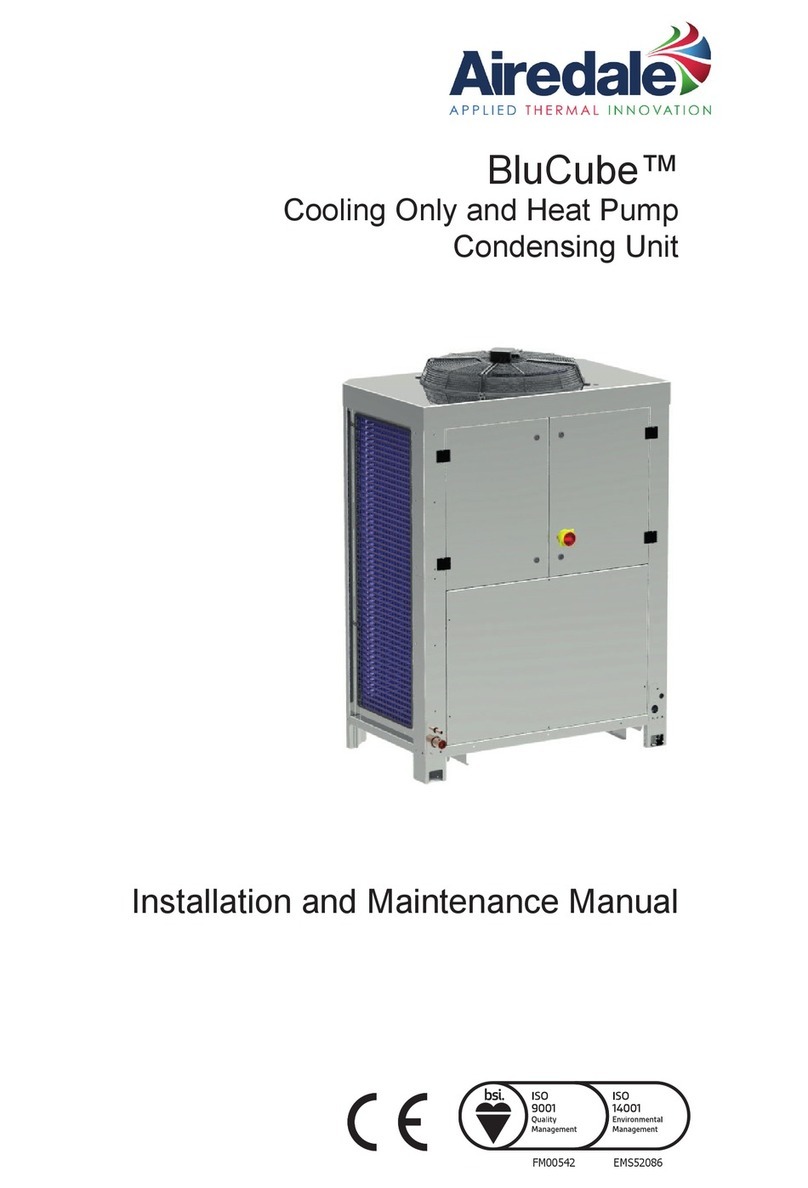
8
VIII. INSTALLATION
A. GENERAL
1. PRE-INSTALLATION CHECK-POINTS
Before attempting any installation, the following points
should be carefully considered:
a. Structural strength of supporting members.
(rooftop installation)
b. Clearances and provision for servicing.
c. Power supply and wiring.
d. Air duct connections.
e. Drain facilities and connections.
f. Location for minimum noise.
2. LOCATION CONSIDERATIONS (CORROSIVE
ENVIRONMENT)
These units are designed for outdoor installations. They
can be mounted on a slab or rooftop. They are not to be in-
stalled within any part of a structure such as an attic, crawl
space, closet, or any other place where condenser air ow
is restricted or other than outdoor ambient conditions pre-
vail. Since the application of the units is of the outdoor type,
it is important to consult your local code authorities at the
time the rst installation is made.
The metal parts of this unit may be subject to rust or deteri-
oration in adverse environmental conditions. This oxidation
could shorten the equipment’s useful life. Salt spray, fog or
mist in seacoast areas, sulphur or chlorine from lawn watering
systems, and various chemical contaminants from industries
such as paper mills and petroleum reneries are especially
corrosive.
If the unit is to be installed in an area where contaminants
are likely to be a problem, special attention should be
given to the equipment location and exposure.
a. Avoid having lawn sprinkler heads spray direction on the unit
cabinet.
b. In coastal areas, locate the unit on the side of the building
away from the waterfront.
c. Shielding provided by a fence or shrubs may give some pro-
tection.
d. Elevating the unit off its slab or base enough to allow air
circulation will help avoid holding water against the basepan.
e. Frequent washing of the cabinet, fan blade and coil with
fresh water will remove most of the salt or other contaminants
that build up on the unit.
f. Regular cleaning and waxing of the cabinet with an automo-
bile polish will provide some protection.
g. A liquid cleaner may be used several times a year to remove
matter that will not wash off with water.
Several different types of protective coatings are offered in
some areas. These coatings may provide some benet, but the
effectiveness of such coating materials cannot be veried by
the equipment manufacturer.
The best protection is frequent cleaning, maintenance and
minimal exposure to contaminants.
B. OUTSIDE SLAB INSTALLATION
(Typical outdoor slab installations are shown in Figure 2.)
1. Select a location where external water drainage cannot col-
lect around the unit.
2. Provide a level concrete slab extending 3" beyond all four
sides of the unit. The slab should be sufcient above grade
to prevent ground water from entering the unit.
IMPORTANT: To prevent transmission of noise or vibration,
slab should not be connected to building structure.
3. The location of the unit should be such as to provide proper
access for inspection and servicing.
4. Locate unit where operating sounds will not disturb owner
or neighbors.
5. Locate unit so roof runoff water does not pour directly on
the unit. Provide gutter or other shielding at roof level. Do
not locate unit in an area where excessive snow drifting
may occur or accumulate.
6. It is essential that the unit be elevated above the base pad
to allow for condensate drainage and possible refreezing of
condensation. Provide a base pad which is slightly pitched
away from the structure. Route condensate off base pad to
an area which will not become slippery and result in per-
sonal injury.
IMPORTANT: Avoid blocking openings in bottom of unit.
7. Where snowfall is anticipated, the height of the unit above
the ground level must be considered. Mount unit high
enough to be above average area snowfall and to allow for
proper condensate drainage.
IMPORTANT: Avoid blocking openings in bottom of unit.
C. CLEARANCES
The following minimum clearances must be observed for
proper unit performance and serviceability.
1. Provide 30" minimum clearance at the front and 18" on the
right side of the unit for service access. Provide 12" mini-
mum clearance on the left side of the unit for air inlet.
2. Provide 60" minimum clearance from top of unit.
3. Unit is design certied for application on combustible oor-
ing with 0" minimum clearance.
4. See Figure 2 for illustration of minimum installation-service
clearances.
D. ROOFTOP INSTALLATION
1. Before locating the unit on the roof, make sure that the
strength of the roof and beams is adequate at that point to
support the weight involved. (See specication sheet for
weight of unit.) This is very important and user’s responsi-
bility.
2. The unit should be placed on a solid and level platform of
adequate strength.
IMPORTANT: Avoid blocking openings in bottom of unit.
(See Figure 3). Provision for disposal of outdoor coil defrost
water runoff must be provided.
3. The location of the unit on the roof should be such as to
provide proper access for inspection and servicing.
IMPORTANT: If unit will not be put into service immediately, cover
supply and return openings to prevent excessive condensation.
WARNING
DISCONNECT ALL POWER TO THE UNIT BEFORE
STARTING MAINTENANCE. FAILURE TO DO SO CAN
RESULT IN SEVERE ELECTRICAL SHOCK OR DEATH.
!
































